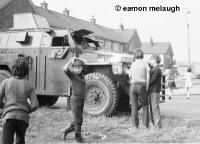
Children - A Summary of the Issues[Key_Events] [KEY_ISSUES] [Conflict_Background] CHILDREN: [Menu] [Reading] [Summary] [Background] [Main_Pages] [Statistics] [Photographs] [Sources] Material is added to this site on a regular basis - information on this page may change
A Summary of the Issues
It is increasingly recognised that childrens involvement in the Troubles has been complex and wide ranging though little documented. Their roles and experiences as victims, perpetrators and peacemakers will cast a long shadow into the future of a stable peace in Northern Ireland. Since the first ceasefire in 1994 an increasing number of projects have documented the impact of the troubles on children and young people, including the numbers killed and injured as a result and the emotional and psychological effects on them. Childrens experiences of political violence may vary widely between geographical areas, within communities, at different times of their childhood and between girls and boys. They may be harassed and pressured from within their community as well as targeted from outside or experience harassment and violence from the security forces. Children have also carried out acts of political violence and participated widely in paramilitary and sectarian organisations. Participation in political violence may be underpinned by understandings of nationalism and identity fostered through segregated schooling. Several major studies have also attempted to get behind the classroom door to assess if and how children are socialised into sectarianism. There are also many initiatives which have sought to bring an end to violence using children as peacemakers and bearers of cross community initiatives including Education for Mutual Understanding (EMU) integrated schools, holidays and cultural activities.
|
CAIN
contains information and source material on the conflict
and politics in Northern Ireland. CAIN is based within Ulster University. |
|
|
|||
|
Last modified :
|
||
|
| ||